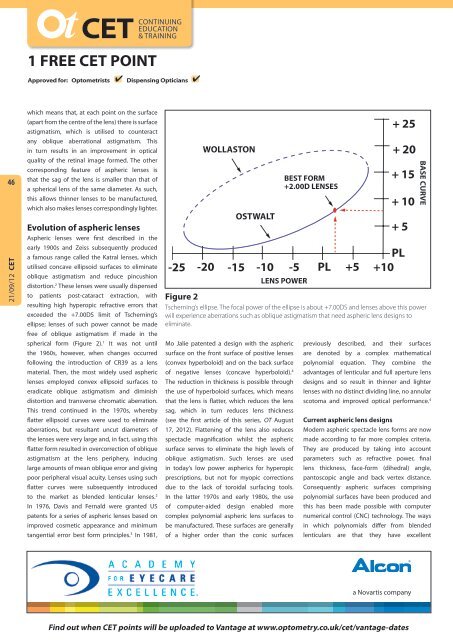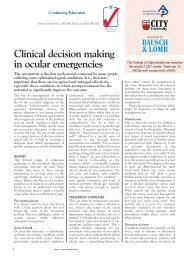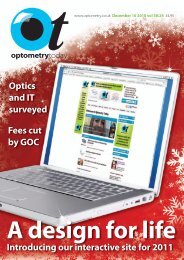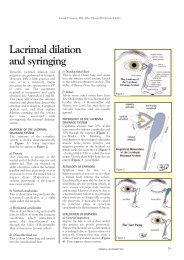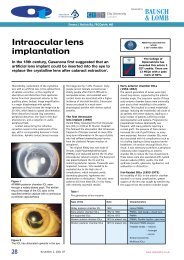Aspheric Lenses - Optometry Today
Aspheric Lenses - Optometry Today
Aspheric Lenses - Optometry Today
Create successful ePaper yourself
Turn your PDF publications into a flip-book with our unique Google optimized e-Paper software.
CET CONTINUING<br />
& EDUCATION<br />
TRAINING<br />
1 FREE CET POINT<br />
OT CET content supports <strong>Optometry</strong> Giving Sight<br />
Approved for: for: Optometrists Optometrists<br />
4 Dispensing 4 Dispensing Opticians Opticians<br />
4 4 Having trouble signing in to take an exam? View CET FAQ Go to www.optometry.co.uk<br />
48 46<br />
21/09/12 20/04/12 CET<br />
to which quiet means activities that, at each (eg, point puzzles on the surface and<br />
colouring) (apart from the rather centre than of the allowing lens) there children is surface<br />
to astigmatism, become which excited is utilised by playing to counteract with<br />
any oblique aberrational astigmatism. This<br />
active items. Remember that children<br />
in turn results in an improvement in optical<br />
may resent being dragged away from a<br />
quality of the retinal image formed. The other<br />
toy corner to have an eye examination.<br />
corresponding feature of aspheric lenses is<br />
Think about the equipment on display in<br />
that the sag of the lens is smaller than that of<br />
your a spherical examination lens of the room. same Is diameter. it unfamiliar As such,<br />
and this allows scary? thinner Is it computerised lenses to be manufactured,<br />
and highly<br />
attractive which also makes to inquisitive lenses correspondingly fingers? Can lighter. you<br />
place unnecessary equipment behind a<br />
Evolution of aspheric lenses<br />
screen? Can you replace your information<br />
posters <strong>Aspheric</strong> lenses with were children’s first described pictures? in the<br />
Arrange early 1900s your and Zeiss appointment subsequently book produced to<br />
avoid<br />
a famous<br />
unnecessary<br />
range called<br />
waiting<br />
the Katral<br />
and<br />
lenses,<br />
to<br />
which<br />
give<br />
utilised concave ellipsoid surfaces to eliminate<br />
flexibility. Some practitioners like to<br />
oblique astigmatism and reduce pincushion<br />
reserve one whole session per week for<br />
distortion. 2 These lenses were usually dispensed<br />
children. For older children, reserving<br />
to patients post-cataract extraction, with<br />
after-school<br />
resulting high<br />
appointments<br />
hyperopic refractive<br />
can be<br />
errors<br />
useful.<br />
that<br />
When exceeded the the appointment +7.00DS limit is made, of Tscherning’s it may be<br />
helpful ellipse; lenses to discuss of such parental power cannot concerns be made and<br />
determine free of oblique whether astigmatism an extended if made or second in the<br />
appointment spherical form might (Figure be needed. 2). 1 It was Remember not until<br />
to the allow 1960s, time however, during when the changes examination occurred to<br />
explain following what the introduction is going to happen of CR39 and as a after lens<br />
the<br />
material.<br />
examination<br />
Then, the<br />
to<br />
most<br />
discuss<br />
widely<br />
the<br />
used<br />
outcome<br />
aspheric<br />
lenses employed convex ellipsoid surfaces to<br />
with both the child and the parent(s).<br />
eradicate oblique astigmatism and diminish<br />
Some children, particularly those<br />
distortion and transverse chromatic aberration.<br />
with special needs, may be nervous.<br />
Consider allowing children to visit the<br />
practice before their first appointment,<br />
to meet the staff and see the room<br />
WOLLASTON<br />
where the examination will take place. In order to successfully test + 20 children,<br />
There are children’s books about eye it may be necessary to purchase tests<br />
tests available so consider loaning a specifically designed for the age group.<br />
BEST FORM<br />
+ 15<br />
book at the time the parent makes the +2.00D Of LENSES equal importance is the attitude<br />
appointment. Some practitioners create of all staff, the practice environment<br />
their own leaflets especially for children. and the approaches taken<br />
+ 10<br />
to make<br />
Staff training may be OSTWALT needed as not the entire experience child-friendly.<br />
everyone has a natural rapport with<br />
In this case leave the door open or<br />
have another member of staff join you.<br />
Conclusion<br />
About the author<br />
+ 25<br />
children. Ensure that all members of staff<br />
are familiar with child protection issues Maggie Woodhouse is senior lecturer<br />
PL<br />
and local protocols (see the College of at the School of <strong>Optometry</strong> and Vision<br />
Optometrists’ -25 -20guidelines -15 on -10 examining -5 Sciences, PL Cardiff +5 University, +10 where she<br />
the younger child and consider LENS studying POWERspecialises in paediatric optometry.<br />
the e-learning module on safeguarding She runs the Special Assessment<br />
Figure 2<br />
children provided by DOCET). It is Clinic, which caters for patients of all<br />
Tscherning’s ellipse. The focal power of the ellipse is about +7.00DS and lenses above this power<br />
good practice to ensure that a child is ages with disabilities. Her particular<br />
will experience aberrations such as oblique astigmatism that need aspheric lens designs to<br />
never eliminate. alone with a member of staff. interests are visual development in<br />
This extends to the examination; ensure children with Down’s syndrome and the<br />
that Mo Jalie a parent patented or a design guardian with comes the aspheric into<br />
the surface examination the front room surface with of positive the child. lenses<br />
previously impact of described, visual defects and on their education. surfaces<br />
are denoted by a complex mathematical<br />
This (convex may hyperboloid) not always and be on the possible back surface eg, a polynomial References equation. They combine the<br />
parent<br />
of negative<br />
may<br />
lenses<br />
need to<br />
(concave<br />
take a<br />
hyperboloid).<br />
distracting<br />
4 advantages<br />
See www.optometry.co.uk/<br />
of lenticular and full aperture lens<br />
The reduction in thickness is possible through designs and so result in thinner and lighter<br />
sibling outside, or an older child may clinical. Click on the article title and<br />
the use of hyperboloid surfaces, which means lenses with no distinct dividing line, no annular<br />
not want the parent to accompany them. then on ‘references’ to download.<br />
that the lens is flatter, which reduces the lens scotoma and improved optical performance. 4<br />
This trend continued in the 1970s, whereby sag, which in turn reduces lens thickness<br />
flatter Module ellipsoid curves questions were used to eliminate Course (see the first code: article of this C-18705 series, OT August O/D Current aspheric lens designs<br />
aberrations, but resultant uncut diameters of 17, 2012). Flattening of the lens also reduces Modern aspheric spectacle lens forms are now<br />
PLEASE NOTE There is only one correct answer. All CET is now FREE. Enter online. Please complete online by midnight on May 18, 2012 – You will be unable to submit<br />
the exams lenses after were this very date. large Answers and, to in the fact, module using will this be published spectacle on www.optometry.co.uk/cet/exam-archive. magnification whilst the aspheric CET points made for according these exams to will far be more uploaded complex to Vantage criteria.<br />
flatter on May form 28, resulted 2012. Find in out overcorrection when CET points of will oblique be uploaded surface to Vantage serves at to www.optometry.co.uk/cet/vantage-dates<br />
eliminate the high levels of They are produced by taking into account<br />
astigmatism at the lens periphery, inducing oblique astigmatism. Such lenses are used parameters such as refractive power, final<br />
1. Diagnosing a congenital colour vision defect in early childhood c) Uses a flashing colourful target<br />
large has amounts the following of mean benefits oblique EXCEPT: error and giving in today’s low power d) Uses aspherics a large for target hyperopic lens thickness, face-form (dihedral) angle,<br />
poor a) The peripheral defect can visual be treated acuity. <strong>Lenses</strong> using such prescriptions, but not for myopic corrections pantoscopic angle and back vertex distance.<br />
b) Teachers can understand a child’s colour choice in artwork<br />
3. Success in eye health examination of a young child may be improved if<br />
flatter c) Inappropriate curves were career subsequently plans can be avoided introduced due to the lack of<br />
the<br />
toroidal<br />
practitioner:<br />
surfacing tools. Consequently aspheric surfaces comprising<br />
to d) the Alternatives market to as colour blended coding lenticular can be used lenses. 2 In the latter 1970s a) and Asks early the child 1980s, to sit the as still use as possible polynomial for as long surfaces as it takes have been produced and<br />
In 1976, Davis and Fernald were granted US of computer-aided<br />
b)<br />
design<br />
Asks the child<br />
enabled<br />
to keep<br />
more<br />
looking at<br />
this<br />
an interesting<br />
has been<br />
picture<br />
made<br />
on<br />
possible<br />
the wall,<br />
with<br />
no matter<br />
computer<br />
2. Measuring eye movements in children is likely to be more what<br />
patents successful for a if series the practitioner:<br />
of aspheric lenses based on complex polynomial c) aspheric Uses a slit-lamp lens surfaces and a Volk to lens numerical control (CNC) technology. The ways<br />
improved a) Moves the cosmetic target very appearance slowly and minimum be manufactured. These d) Examines surfaces sections are generally of the eyes in in separate which intervals polynomials differ from blended<br />
b) Avoids distracting the child by speaking<br />
tangential error best form principles. 3 4. Practice preparation may include all of the following EXCEPT:<br />
In 1981, of a higher order than the conic surfaces lenticulars are that they have excellent<br />
+ 5<br />
BASE CURVE<br />
a Novartis company<br />
Find Find out out when when CET CET points points will will be be uploaded to to Vantage at at www.optometry.co.uk/cet/vantage-dates


